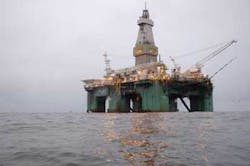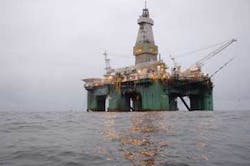Mixed response to Norway’s Barents Sea initiative
Licenses awarded, some acreage still off-limits
Nick Terdre, Contributing Editor
With the award of new licenses and the introduction of an integrated management plan, the Norwegian government hopes to have created the conditions to boost exploration and production in the Barents Sea.
Progress has been muted in recent years, not least due to the moratorium on activity which meant no exploration or appraisal wells were drilled between November 2001 and December 2004. Even when the ban was lifted and exploration resumed in January 2005, the future for production remained unclear while the government investigated whether it was compatible with the sensitive environment and other marine activities such as fishing.
The conclusion, as set forth in the integrated management plan published in March, is that it is compatible, with some provisos.
While opportunities to explore in the Norwegian Barents have been limited in recent years, interest in the region as a whole has been growing fast. One reason is the US Geological Survey’s claim that 25% of undiscovered hydrocarbon resources are located in Arctic waters. Another is the tantalizing prospect of the hydrocarbon wealth waiting to be developed in the Russian Barents, leading Statoil and Hydro, along with other international oil companies, to bid high for a stake in Gazprom’s Shtokman development.
The Norwegian government, along with the country’s oil industry, is not immune to Barents fever. “We believe the Barents Sea could represent a new petroleum province for Europe,” Oil and Energy Minister Odd Roger Enoksen says. “The Norwegian government has an active policy for further exploration of the Norwegian part of the Barents Sea.”
“The High North [as the Barents is often referred to in Norway] is Europe’s new energy region,” says foreign affairs minister Jonas Gahr Støre. “Now we are looking at openings for petroleum development in the near future in both the Norwegian and the Russian part of the Barents Sea.”
How realistic the optimism concerning the Norwegian Barents’ hydrocarbon potential remains to be seen. The Norwegian Petroleum Directorate (NPD) estimates that the area holds 990 MMcm of oil equivalent (6.2 Bboe) in undiscovered resources, of which 60% is gas. But knowledge of the area is limited, so there is a great degree of uncertainty around this estimate. Moreover, many of the play models have yet to be confirmed, so exploration is still in a relatively early phase.
Activity so far has yielded relatively little. From 63 exploration and appraisal wells drilled since the first licenses were awarded in 1981, the only commercial finds have been the Snøhvit/Albatross/Askeladd cluster of gas fields which Statoil is now developing, and the Goliat oil field which Eni will continue appraising later this year.
Three exploration wells have been drilled since the moratorium was lifted - Statoil’s Guovca and Uranus, and Hydro’s Obelix. All were either dry or found only hydrocarbon traces.
Opinions among oil companies about prospects in the Norwegian Barents also are mixed. Majors such as BP, ExxonMobil, and Shell, which are focusing efforts elsewhere in the Norwegian sector, are staying away. The six 19th round licenses awarded in March throw some light on which companies are interested. Of the operatorships, three went to Statoil, two to Hydro, and one to UK gas company BG. Among the partners in the licenses are Chevron, Discover, Eni, Gaz de France, Hess, RWE Dea, and Total.
A recent study by the Sintef research institute brings a realistic perspective to the assessment of the Norwegian Barents’ potential, providing some useful pointers as to where exploration efforts should be focused. Based on erosion mapping, the study found that in some areas large quantities of oil and gas were lost to migration 30-40 million years ago as seabed uplift and erosion led to fracturing of the cap rock. Other areas were left unaffected by these processes, and the study points out that the discoveries that have been made indicate that there are prospective areas.
The integrated management plan opens most of the southern Barents to exploration and production. The northern part has never been licensed. There are some restrictions. Activities are banned in the following areas:
- A 65-km zone around Bjørnøya (Bear Island)
- At the ice edge and polar front which extends close to Bjørnøya
- In the Eggakanten area at the edge of the continental shelf to the north of the Tromsø Patch
- In the first 35 km out from the northern coast
- In the Troms II area in the southwest Barents.
In addition, no new activities are permitted in the area lying 35-50 km from the coast, but work on existing licenses, which include some of the recently awarded 19th round licenses and the PL 229 license on which Goliat lies, can take place.
In Eggakanten provision is made for mapping to be carried out, and in Troms II both mapping and seismic data acquisition are permitted, indicating that the off-limits status of these areas may be only temporary. Troms II adjoins Nordland VII which together with Nordland VI lies in the northern Norwegian Sea - the oil industry considers these areas very prospective. The plan also bans activity in Nordland VI and VII, but opens Nordland VII for mapping.
Most of the restrictions only apply for the life of the current government, and will be reviewed, along with the whole plan, in 2010.
| License | Block | Operator |
|---|---|---|
| PL 110C | 7123/4 (part) | Statoil |
| PL393 | 7124/6, 7125/4&5 (parts) | Hydro |
| PL 394 | 7224/6, 7225/4 | Hydro |
| PL 395 | 7226/2&3, 7227/1 | Statoil |
| PL 396 | 7228/1&2 | BG |
| PL 397 | 7230/2,3,4,5&6, 7231/4 | Statoil |

